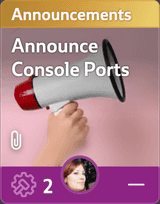
Riad is the product manager of Codecks. He is also the co-founder of indie games company Maschinen-Mensch and still believes that Street Fighter 2 is the most beautiful video game ever created. Coincidentally he also believes that Codecks is the best project management tool for game developers. Apparently he has been creating video games for over 14 years now and considers himself a productivity nerd: scrum, kanban, extreme programming, waterfall, seinfeld. He has tried it all.
Codecks is a project management tool inspired by collectible card games. Sounds interesting? Check out our homepage for more information.
How to pitch your game to publishers (+ Template)

Mastering the art of crafting a compelling pitch for your game might be the most important skill that you’ll need when running a game studio. While we might instinctively associate pitching with seeking publishers, its significance stretches so far beyond that:
- Securing development funding from a publisher.
- Attracting company investments from venture capitalists.
- Convincing a grant agency to approve government funding.
- Captivating the interest of gaming journalists or streamers.
- Inspiring your development team around a shared vision.
- Attracting new talent to your studio.
- Gaining the support of your publisher’s marketing team (this can be trickier than you’d expect).
- And, of course, captivating your audience and encouraging them to dive into your game.
Each opportunity may come with its unique set of requirements, yet there’s a common thread running through all of them: not just a conviction that what you’re creating brings value to the world, but a clear way of communicating that helps people join your vision.
Guiding Principles
In this article I will focus on the aspect of pitching to a publisher, but a lot of these techniques and frameworks can also be applied to the other situations which require you to effectively communicate about your game. Lets first discuss the general framework, before diving into the concrete components that your pitch deck should have:
1. Skip the inbox
Publishers usually have public emails or submission forms right on their websites. But here’s the thing: individual scouts might get thousands of pitches every year, sometimes dozens in just a day. To manage this deluge, they often sift through submissions in stages. At first, interns or junior staff might skim through pitches before passing them to more experienced scouts. But sometimes, there’s no filtering system at all. In such cases, your pitch could land straight in the jam-packed inbox of a swamped scout. It might be weeks before they even get a chance to analyze your submission.
Reaching out to someone for the first time? That’s called a “cold pitch.” But if you can, shoot for a “warm pitch” instead. This means you either already had a friendly interaction with the publisher, or a mutual buddy who’s respected by both of you gives you an introduction. Making the shift from cold to warm pitching amps up your chances of going into a deeper conversation by a lot.
So unless you already have a personal connection to the scout, your first step before sending the pitch should be to find a mutual connection. What do I usually do? I simply ask around in my circle. A pro-tip: check the scout’s LinkedIn profile for any common connections. This underscores why it’s crucial to build your network early, way before you really need it. With this groundwork in place, pitching becomes much easier, especially when compared to cold-contacting a top scout just when you’re hoping they’ll love your project.
Want a solid way to build your network? Learn how to make the most out of attending game conferences.
2. Pitch in-person
If you can, always go for in-person pitches. From what I’ve seen, processes that dragged on for months can speed up dramatically with a face-to-face meeting. One sit-down might save you a flurry of emails and weeks of back-and-forth questions. Game conferences are prime spots for this, letting you knock out multiple pitches in a short span. And they’re not just for first-time meets; they’re also perfect for follow-ups or casual check-ins, even if you’re not in the market for a deal right then.
Building rapport is crucial. Here’s the straight talk: if people find you likeable, your pitch has a better shot. Being charming isn’t something you can just pick up overnight; it often intertwines with humility and self-confidence. But a practical step you can take immediately? If you’re pitching in person, set aside enough time to establish that connection. Make the interaction feel more collaborative than transactional. Find common interests to engage your audience, drawing them into the story rather than leaving them as mere spectators.
3. Use Game references
While I might bemoan the industry’s occasional lack of innovation just as any other discerning game designer, there’s no denying this: drawing parallels to known games can clarify your vision swiftly. Think about it. Describing your game as “Stardew Valley meets Factorio” instantly paints a vivid picture in your audience’s mind—saving you precious time. This tactic allows you to set a clear baseline, leaving more room to highlight what sets your game apart. An added perk? Your audience will subconsciously link your game with those big hits. So when you pitch to publishers, keep this in mind: while your enthusiasm and genuine interest are vital, you’re ultimately presenting a business proposition and doing something completely unparalleled to anything else on the market might actually be scary to most publishers, rather than something to appreciate.
4. Draw on familiar fantasies
Just as the previous tip suggests referencing known games, this one’s about embracing iconic tropes. While developing “Curious Expedition 1,” we gave folks a behind-the-scenes look, regularly sharing tidbits and images. In a random move, we included a character named Nikola Tesla in a screenshot. The feedback? Overwhelmingly enthusiastic. Think about the weight the name Tesla carries in terms of “brand value”. The recognition that Tesla has gained over the years, thanks to countless books, films, and documentaries, is colossal. And with just one reference, we were tapping into a huge fan base that all of a sudden was much more interested in our game.
It’s akin to the repeated use of Tolkien’s universe components like Orks and Elves in various games. Developers don’t lack the creativity to invent fresh fantasy entities, but introducing, let’s say, Deep Space Rock as “interstellar dwarves” taps into an established narrative worth billions. Introducing a brand-new fantasy race? While creatively intriguing, it’s not just a monetary investment, but also a test of patience. So, be strategic and pick your creative battles. It’s practical to lean on tried-and-true tropes. From there, you can infuse and weave your personal touches. This can also simplify your pitch a lot, rather than spending minutes explaining your basic world building premise you might find your scout to be already a fan of a trope / fantasy that you’re referencing.
5. Game narratives don’t pitch well.
In pitches, your game’s story might not dazzle as you’d wish. Even if that story is the heart and soul of your game, getting others to feel its magic isn’t easy. Think about it: ever tried summarizing your favorite TV show or book to a friend? Despite your best efforts, they just don’t get that emotional pull or the significance of those jaw-dropping moments. So it’s better not to get too caught up in your game’s narrative during pitching. Instead of diving into every twist and turn, highlight the main beats and the significance in terms of production and perceived player value. Don’t get too wrapped up in the specific storyline.
(Writing this feels obvious, but I’ve seen game pitches where people spent over 50% of their pitch retelling the minute details of characters that I had not yet built any emotional connection to. Mention the story and then move on.)
6. Storytelling is a superpower.
Hang on, didn’t I just suggest above going light on game narratives? Yes! But storytelling isn’t limited to your game’s plot—it’s also about your journey and the essence behind the game’s creation, and that is the actual story that you should be focusing on during your pitch. What’s YOUR story? Are you weaving a tale inspired by an ancestor? Sharing a family legend that’s been passed down, and now you’re uniquely positioned to bring it to life within a game? Infusing such genuine touches into your pitch makes it memorable. Always look for those authentic elements that can make your presentation unforgettable.
I always remember vividly when I visited my first conference as a fresh studio founder and a journalist asked me to tell him something interesting to write, but “not about the game, because nobody cares about that.”. Mind you, this was at games conference! And looking back, I can see where he was coming from. The stories about us as creators are as interesting as the stories that we’re forging in our games. Make sure to make them part of your pitch.
Game Pitch Deck Template
Alright, with that groundwork laid, let’s dive into the content you’ll absolutely need in your pitch deck (and yes, you should totally have one!).
- Hero Image Open your first slide with a nice hero image. Even if your game currently boasts just programmer art, it’s worth investing time or money to craft that one standout image. This will encapsulate and convey the thrill of your game. Remember, first impressions count!
- Logline This should be a concise, one-liner that captures the essence of your game. Think of it as the one thing you want people to recall even if they forget everything else. Using shortcuts, as mentioned earlier, can extend this to two sentences. For instance: “Slay the Spire in Space” or “A roguelike card game set against the backdrop of 60ies pulp space adventures.”. I borrow the term “logline” here from movie scripts, where it summarizes a movie script in one sentence.
- Gameplay Pillars Provide a brief rundown of each game system, ideally paired with a sleek screenshot. It’s a chance to showcase the core mechanics and visuals that make your game unique, and it gives a good idea of the overall scope of the game. (How to write modern game design docs for your game.)
- Demo If you got a vertical slice of your game, make sure to include a link. Many publishers won’t give a second glance to pitches without a playable build. If you’re pitching in person, consider diving into a live gameplay session. Also toss in a gameplay video. It’s perfect for those on a tight schedule who might not have the luxury to install and play your game right away. Giving them quick low-threshold taste of the experience can make all the difference. (What to watch out for when creating your video game trailer.)
- Competition Highlight other hit games in your niche, drawing comparisons in gameplay elements. This showcases the thriving market for your genre and pinpoints what sets your game apart. It’s a clear way to demonstrate you’ve done your research and understand where your game stands in the current landscape
- Traction Got some impressive stats or numbers related to the game? Flaunt them here. Whether it’s the size of your X or TikTok following, the number of downloads from a demo, actual gameplay stats (like median play length), or the sales figures from past projects, these can speak volumes. However, if your numbers are a bit underwhelming or not quite relevant, it’s better to leave this slide out. Stick to showcasing your strengths. (Learn on how to build a community for your game.)
- The Team Who’s behind the magic? Showcase the talents crafting this game. Highlight past accomplishments or projects, making it crystal clear why this team is top-notch and perfectly equipped to bring this game to life. This isn’t the place for quirky bios or favorite pizza toppings. Keep it sharp and professional, underscoring capability and experience.
- Timeline Paint a clear picture of where you are in the game’s development journey. Highlight milestones reached, what’s next on the agenda, and, crucially, your projected release date. This gives potential partners a sense of your project’s progression and timeline.
- Target Platforms A no-brainer. Highlight where you intend your game to launch. If you’re feeling a bit snazzy, toss in your target demographics. From my experience, you don’t have to get into the nitty-gritty. Often, if you’ve used game shortcuts as mentioned earlier, that can be enough to set the scene in regard to target audience. (How to design your Steam store page).
- Price Point Sure, the final price might be decided hand-in-hand with your publisher, but suggesting one up front demonstrates foresight. It tells them you’ve considered where your game fits in the market. Plus, it gives them a ballpark for rough calculations on unit sales required for profitability. Coming to the table with some numbers in mind shows that you’re approaching this not just like a creative hobby, but as a business opportunity for both parties involved.
- Required Services Be clear about what you’re expecting from the publisher beyond funding. Is marketing assistance on your list, or do you have that covered in-house? How about community management? Porting? QA? Remember, publishers offer more than just a financial boost. They bring expertise and resources to the table. Clearly lay out what you need to ensure your game’s success. This not only clarifies expectations but also shows that you’re not just thinking of the publisher as a bank loaner basically.
- Budget Pinpoint the exact amount you’re seeking. Publishers typically aren’t fans of vague ranges. Determine a solid figure (feel free to tailor this according to who you’re pitching to, but make those adjustments beforehand). Then, present this budget as the precise sum needed to bring your game to fruition. Even though, in reality, budgets can be fluid, publishers prefer to hear a concrete number—it lends confidence and indicates you know what you’re doing, rather than leaving an impression of uncertainty.
Remember, pitching isn’t a sprint; it’s more like a marathon. Unless you’ve struck gold with a viral hit and publishers are knocking down your door, anticipate that the pitching process might span several months. You might face your fair share of rejections, but hey, that’s part of the journey. If you stick to the guidelines we’ve discussed, you’ll be setting yourself up with a solid foundation. Keep your chin up and pitch with confidence!


